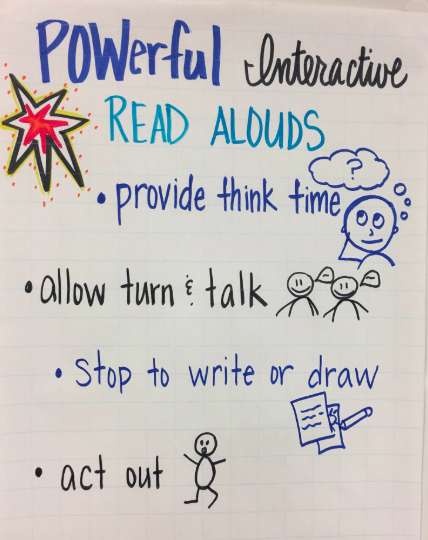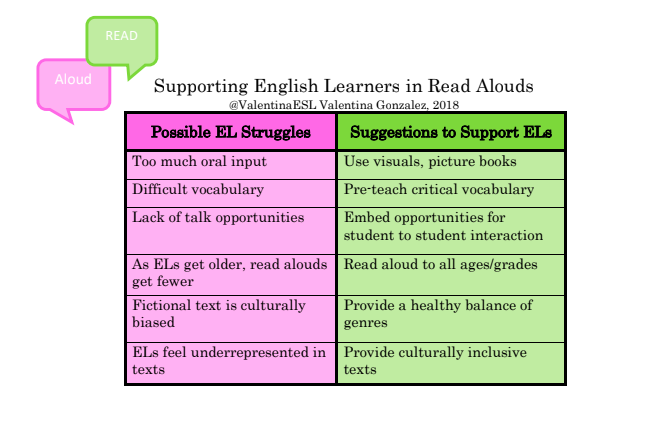|
Do you remember when you were in school and your teacher said it was time for read aloud? I don't know about you, but for me, that was a joyous time. It was a time for my imagination to soar. I could take the words that were flowing so eloquently from her mouth and create a movie in my mind. I loved it. As a classroom teacher, reading aloud to my own students became my favorite thing to do (maybe because it was magical for me as a child). I wanted to share that experience with them. But I also wanted to lift the level of learning a notch. Rather than this time being only a time for input, I was hoping to create some opportunities for output as well. ENTER Interactive Read Alouds! According to the International Literacy Association, a read-aloud is the practice of a teacher orally reading a text with large or small groups. Pictures or text may be shared visually with the students whose primary role is to listen and view illustrations. The intent is to model proficient reading and language, promote conversation, motivate, and extend comprehension and conceptual understandings.
In a traditional (okay, let's just say old school) read aloud, the experience is a one-way street. The teacher reads and the student listen. There is no interaction, discussion, or time for students to express themselves during the read aloud. It's probably what I disliked most about read aloud when I was a kid. No one was allowed to talk while the teacher read. On the contrary, during an Interactive Read Aloud, the teacher provides ample opportunities for students to interact with the text. Students talk with a partner, act out parts of the book, draw a picture related to the reading, or respond in writing. The best Interactive Read Alouds are carefully, pre-planned by the teacher. The teacher can stop to ask questions or have students respond at critical parts of the text when the planning is done ahead of time. The term interactive refers to the active learning that occurs while reading aloud high-quality literature. It characterizes the teacher and students having a conversation as they process the text together. It provides students an opportunity to extend their understandings through talk. This talk provides evidence of their thinking. (Fountas & Pinnell, 2001, 2011) In both cases, whether traditional read aloud or interactive, the teacher models proficient reading so students can hear what an expert reader sounds like and how a reader engages with text. The teacher also models thinking about the text. What is happening? What is the character doing and why? What am I thinking now? Basically, students get to hear what happens in the reader's head. They are also able to experience a text that is at a higher level than they are capable of reading on their own. And this is big for students who are reading below grade level. Imagine if students are only able to interact with text that they are capable of decoding. Gaps are created. When we read aloud to students, we invite them to interact with text at higher levels than they are able to decode on their own. Typically, kids can think, speak, and listen at higher levels than they are able to read independently. Steps to creating your own Interactive Read Aloud: •Select a book and a focus •Preread the book and think about your thinking •Select 3-7 vocabulary words or phrases to highlight •Make purposeful stopping points and note them in your book with a sticky note •Use gestures, eye contact, visuals and expression to support ELLs In this video, Linda Hoyt explicitly demonstrates with students how to talk to your Thinking Partner while she shares an Interactive Read Aloud on a nonfiction book. (5 minute clip) The value of a read aloud, whether it be interactive or not, cannot be underestimated. Children of all ages benefit from being read to regularly. I'm an advocate for daily! This TED Talk by Rebecca Bellingham speaks volumes about the benefit of reading aloud. If you have 9 1/2 minutes to spare, watch it and then share it with teachers and parents! We all need a reminder every now and then. Research has demonstrated that the most effective read-alouds are those in which children are actively involved asking and answering questions and making predictions rather than passively listening (Dickinson, 2001).
2 Comments
Steven Jones
3/3/2021 09:24:05 pm
I teach junior high the ELL but I have one small group of newcomers students who are at the very beginning of their English journey. I'm more familiar with young adult literature than books whose lexile is closer to these students'. Do you have any suggestions of books with stories that new learners could follow that are not too childish?
Reply
Valentina
3/4/2021 08:47:24 am
Hi Steven,
Reply
Your comment will be posted after it is approved.
Leave a Reply. |
Categories
All
|




 RSS Feed
RSS Feed
